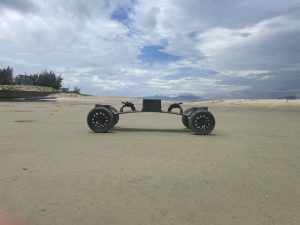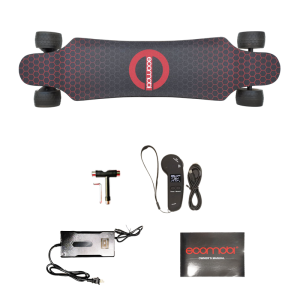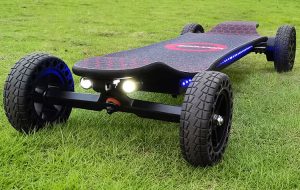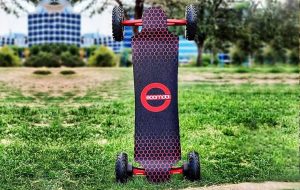Electric skateboards have transformed urban mobility, offering a sustainable and enjoyable way to zip around town. However, riding an electric skateboard in wet conditions requires proper care to avoid damage and performance issues. This article provides tips for keeping your board in top shape after getting wet.
Cleaning the Board

Cleaning an electric skateboard is essential, especially after riding in wet conditions. Moisture and dirt can damage the board’s components if left uncleaned, leading to potential breakage and reduced performance.
The first step in cleaning an electric skateboard after a wet ride is wiping down the board with a dry cloth. This process helps remove any excess moisture or debris from the surface of the board. Using a brush to clean debris and dirt from hard-to-reach areas such as wheels, bearings, and motors can also help keep the board running smoothly.
Once the board has been cleaned, it’s important to dry the components properly to prevent water damage. This process involves removing the battery and ensuring it’s dry before reinserting it into the board. Leaving the battery in a wet skateboard can lead to rust and short circuits, so checking it regularly is crucial.
To dry the board components, always use a dry cloth or towel. It’s recommended to avoid using a heat gun, blow dryer, or any other heating element that could damage sensitive parts. Once the components are dry, reassemble the board and store it safely.
Checking Electrical Components

After riding an electric skateboard in wet conditions, it’s critical to check and inspect the electrical components thoroughly. This practice can help ensure that these essential parts are free from water damage, rust, or other debris that could cause performance issues or mechanical failures.
The battery is one of the most critical electrical components in an electric skateboard, and riders should take extra care when checking it. Ensure it is dry and there is no risk of water penetrating the contacts or wiring. If any signs of water damage or corrosion are detected, it’s best to replace the battery entirely to prevent potential hazards.
Checking the charger is also essential. Make sure it’s dry and free from any water damage before using it again. Any moisture or debris present can not only pose a safety hazard but also damage sensitive charging circuits, leading to battery overcharging or complete failure.
Lastly, inspecting the motor after wet rides is crucial to maintaining peak performance over time. Check for any moisture, dirt, or other debris inside the motor housing that may cause the motor to malfunction or fail. It’s best to use a dry cloth to wipe away any visible debris or moisture before reassembling the motor.
Lubricating Bearings and Hardware

Lubricating the bearings and hardware of an electric skateboard is crucial after wet riding. Exposure to moisture can cause rust and other damages that may reduce the board’s performance and lifespan.
Lubricants provide a protective barrier against corrosion and wear, helping to keep components running smoothly over time. Many different types of lubricants are available, including silicone spray, lithium grease, and oil-based lubricants.
When applying lubricant to the bearings, it’s best to remove them from the wheels first. Clean the bearings with a dry cloth before adding lubricant to each bearing. Avoid over-lubricating by using only a few drops per bearing, which can help prevent dust and debris build-up.
For hardware, it’s recommended to apply lubricant to any bolts or screws regularly. Removing rust and dirt from these parts beforehand can help increase the effectiveness of the lubricant. Add a small amount of lubricant to each bolt or screw and use a cloth to spread it evenly across the surface.
Storage Considerations

Storing an electric skateboard correctly after wet riding is essential for protecting it from further damage and ensuring optimal performance.
The best storage practices for an electric skateboard involve keeping it in a dry place with adequate ventilation. Avoid storing the board in high-humidity environments or areas with extreme temperatures that could cause condensation or other damage to sensitive components.
Some riders prefer to remove or apply a rust-inhibiting lubricant to protect the board’s bearings and wheels during storage. Covering the board with a protective bag or a cloth also helps keep any moisture or dust away from the board’s components.
When storing an electric skateboard for longer periods, riders should ensure the battery is charged to around 50% before turning it off. This practice can help extend its lifespan, and riders should avoid leaving it uncharged for extended periods.
Conclusion
In summary, taking good care of your electric skateboard following use in wet conditions by thoroughly cleaning, lubricating, inspecting, and storing it can greatly maximize its performance, lengthen the lifespan of its components, and keep it always prepared for smooth rides no matter what the weather. By simply incorporating a few practical post-ride habits into your routine, you can look forward to many more exhilarating miles on your board for years to come. And if you’re looking for an electric skateboard that’s built to withstand damp environments, Ecomobl’s electric skateboards are definitely worth checking out. With the latest waterproof ESC technology, these boards offer excellent reliability and performance even in challenging weather conditions. So why not explore the range and experience the difference for yourself?
Read More
- Shopping Guide Of Skateboard With Remote Control
- Review Of Best Hub Motor Skateboard With Cool Lights
- Practical Style Electric Skateboards Commute
- Off Road Electric Skateboards Safety
- Fix Electric Skateboard Cannot Charge




